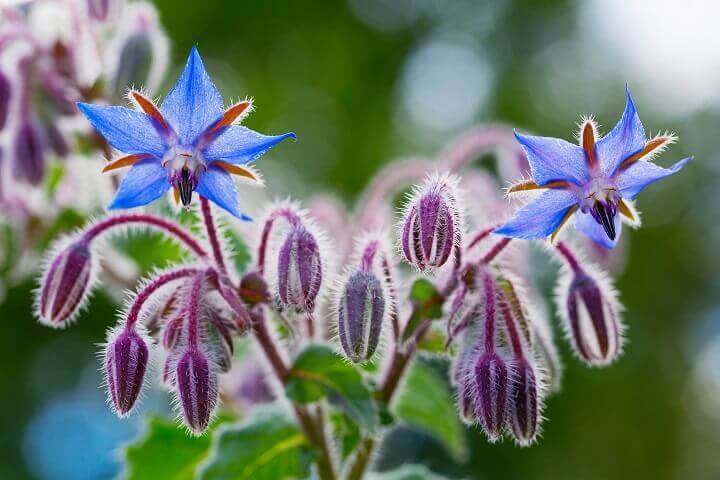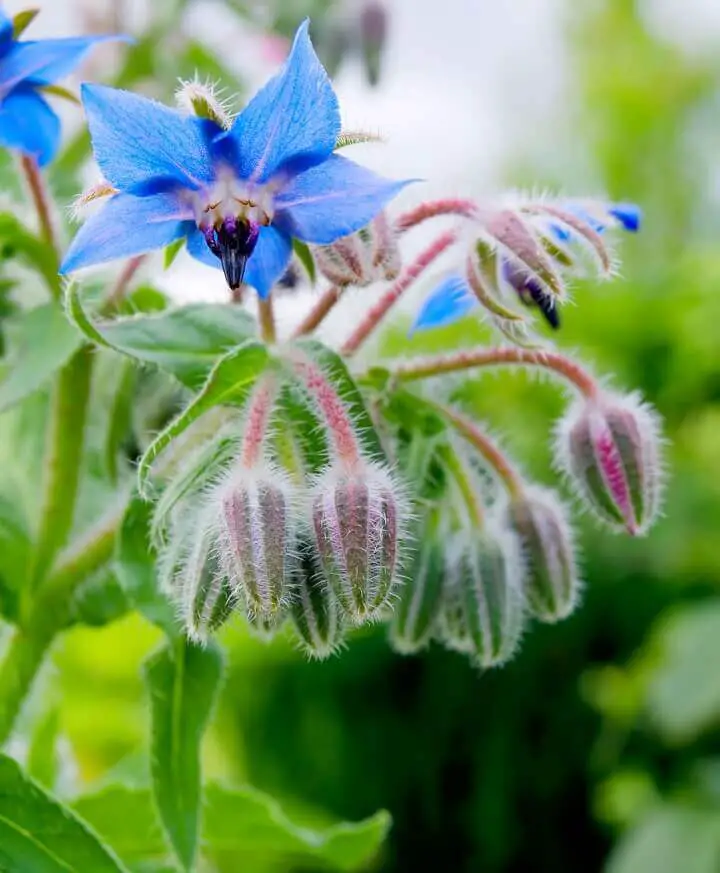Estimated reading time: 9 minutes
Although some people think of borage as a nuisance weed, this self-seeding herb has plenty of great uses around the home, on the homestead, and for prepping. You can use it in recipes, grow it for your chickens, and even plant it to help your garden grow.
In this article, we’ll talk about some brilliant uses for borage. We’ll look at medicinal, culinary, and garden uses for this beautiful flowering plant. But first, let’s talk about what it is and how to grow it.
What Is Borage?
Borage is an annual plant with showy, blue flowers. The star-shaped blooms give the plant its common name, starflower. Although it is an annual, it aggressively reseeds itself to grow year after year. For this reason, some think of it as a nuisance weed, but it has plenty of commercial and home garden purposes.
Borage has been around since Roman times when Pliny the Elder mentioned it in reference to an anti-depressant. Also known as Borago officinalis, this easy-to-grow herb is a member of the forget-me-not family. Borago, which probably refers to borra, an Italian word for wool or hair. Borage is covered in white, fuzzy hairs.
Want to save this post for later? Click Here to Pin It On Pinterest!

How to Plant and Grow Borage
Borage isn’t a very demanding plant at all. It will thrive in everything from full sun to part shade, although it will grow faster and bloom more with more sun. You can grow it in containers, herb gardens, or as a cover crop sweeping across an entire meadow if you like.
It isn’t picky about its soil, either, it just doesn’t like being in wet, soggy soil, and it will grow in USA Hardiness Zones 2 -11. You can start borage seeds indoors or direct sow them in your garden.
Start with good, well-draining soil. If your soil is too soggy, consider mixing in some compost, sand, peat moss, or aged manure to create better drainage. Compost will also add fertilizer to the soil, which is excellent for borage.
If you are growing borage in a container, keep in mind that it has a long taproot, so you’ll need to grow it in a container that is at least 12 inches deep and 12 inches wide.
Direct Sow Borage Seeds
Direct sow your seeds after all danger of frost has passed or start them inside 3 to 4 weeks ahead of time. Plant borage seeds about ¼ inch deep and about 12 inches apart. Cover lightly with soil. Water lightly and keep the soil damp until the seeds begin germinating, which takes about a week or two.
Once the true leaves emerge, you can slow down the watering rate. When the plants are 6 inches high, thin them to about 12 inches apart.
Transplanting Borage
If you started your seeds indoors, once they are about 6 inches high and all danger of frost has passed, you can harden them off and then transplant them into your garden. Just be extra careful when transplanting your borage because the tender taproot can be damaged easily.
Borage reaches maturity at about eight weeks, so you can succession plant throughout the summer up until eight weeks before your first frost date. It can reach two to three feet tall and just as wide under ideal conditions.
However, Borage is not frost hardy, so its season is over once fall frost begins. But don’t worry, borage reseeds itself so well that you will probably have a new crop in the spring without having to plant new seeds.
To prevent borage from reseeding, harvest or remove all of the flowers before they go to seed. Conversely, to encourage more blooms, you can deadhead your borage plants.
Pruning and Fertilizing
You can prune borage to about half its size in the midsummer to encourage bushier plants. Water well when the soil dries out. You can fertilize borage with a compost tea, but don’t over-fertilize, or the plant will develop foliage but won’t bloom.
Harvesting Borage
Harvest borage leaves when they are young and tender before the hairs have developed. The older leaves may have very stiff, bristly hairs. You can harvest flowers at any time by snipping off individual flowers or clusters.
Also, this plant's lower leaves and stems may have stiff hairs. These hairs can irritate the skin or the lungs, so be careful when working with the plant.
How to Use Borage
This plant is hardy and easy to grow, and it has multiple uses.
Medicinal Uses
1. Borage Tea
Practical Self Reliance talks about making borage tea to reduce fevers, coughing, and stress. Just steep ¼ cup of fresh leaves or flowers in a cup of boiling water for about 10 minutes. Add honey if you wish.
2. Borage Tincture
According to Infinite Succulent, borage is helpful for adrenal health and the nervous system. It can also help people who are very hard on themselves. In addition, you can make your own tincture with vodka, fresh leaves, and flowers from your borage plants. In her video, Raquel shows you how to make a borage tincture.
3. Borage Poultice
A poultice made from borage can be used to treat bug bites, itchiness, arthritis, and joint pain. In addition, if you apply it to the chest at night, it can help with congestion.
According to The Lost Herbs, to make a borage poultice, just add enough hot water to dried borage leaves to moisten them. Then apply them like a paste to the affected area and let them dry.
In a pinch, you can make a spit poultice from borage by chewing some of the young tender leaves and then applying them to a bee sting or bug bite.

Culinary Uses
Borage has a sweet and salty cucumber-like flavor used in dishes, desserts, and drinks. You can eat borage raw or cooked. Choose young, tender leaves for eating raw (before hairs have developed). If you are going to cook your borage, the hairs will dissipate when cooking.
4. As a Garnish
Borage has a beautiful blue flower that looks and tastes fantastic. You can use it to garnish desserts, salads, and drinks. In addition, you might try making borage biscuits, such as these.
5. In Salad
The cucumber flavor makes borage a great addition to salads. You can eat the leaves and flowers fresh. As an example, you might want to try borage in a salad, like this one.
6. Borage Beverages
Of course, we already talked about how to make borage tea, but you can also add it to other drinks. You might even want to try making this borage lemonade.
7. Cooking with Borage
You can cook borage just like you would spinach, which will take care of the bristly hairs that grow on the plant. Find more borage recipes, here.
Gardening Uses
8. Companion Planting
Companion planting is planting different species of plants near each other so that they can help others grow. For example, some plants improve the soil, repel pests, and attract pollinators. For instance, Borage makes a great companion plant for specific vegetables.
Borage may repel tomato worms and cabbage worms, making it a good companion for tomatoes and cabbages. Borage may even improve the flavor of strawberries because it adds minerals to the soil.
Borage can also attract pollinators which increases the yield of plants such as zucchini, squash, melons, and cucumbers. Find out more about companion planting with borage here.
9. Cover Crop
You can plant borage as a cover crop and living mulch. First of all, borage can improve the soil. The long taproot can help bring up trace minerals. The taproot also helps to aerate the soil as it permeates deep underground. It can also help remove heavy metals from your soil, as well. It will help prevent erosion and increase soil retention, according to gardenerspath.com.
On the other hand, you can use it as a living mulch because borage grows quickly and has broad leaves. This will shade the ground and help prevent weeds from growing. Then, when you are done with it, you can chop and drop the borage to act as biomass. This will also improve the quality of your soil when you till it.
10. Pest Control
Borage may repel pests such as tomato worms and cabbages worms. It also attracts aphids, which means they’ll be feasting on the borage and not your vegetables. The aphids, in turn, will attract beneficial insects such as ladybugs, which will
11. Fertilizer and Compost
If you have a compost pile, adding borage to it will add nutrients to your compost, benefiting your plants. If you don’t have a compost pile, you can soak borage plants in water for two weeks to make a compost tea, which you can use to water your plants. Find out how to make a borage compost tea, here.
12. To Attract Pollinators and Beneficial Insects
Pollinators just love borage, and it attracts a wide variety of bees and beneficial insects to your garden. Even planting a few borage plants near your garden will help attract bees and other pollinators, which will help your garden produce better.
13. Honey
According to carolinahoneybees.com, borage is often grown to feed commercial beekeeping operations. First, large fields of borage are grown for the bees, who use it to make honey. Then, the bees pollinate the borage, which creates lots of seeds for the following year or to sell.
Borage is especially well-suited for beekeeping in dry areas since the plant can continue to produce nectar even during a dry season.
Borage honey is slow to turn to granules and has a pale, golden color. Every acre of borage can help bees make 200 pounds of honey. Find out more about borage honey here.
14. Grow Borage for Your Chickens
If you grow a chicken garden you can plant borage in it. Not only will it encourage pollinators to visit the plants, it will also improve the soil. Chickens can eat the leaves, flowers, and of course, seeds. If you don’t have a chicken garden, you can plant a few borage plants around your chicken run for them to enjoy throughout the summer.
Like this post? Don't Forget to Pin It On Pinterest!












“It can also help people who are very hard on themselves”….what the hell does that mean?